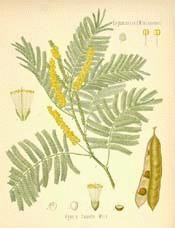
Botanical.com Home Page

|
Catechu, Black
(Acacia catechu)
Click on graphic for larger image
|
Catechu, Black
Botanical: Catechu nigrum, Acacia catechu (WILLD.)
Family: N.O. Leguminosae
---Synonym---Cutch.
---Habitat---Burma, India.
Pale Catechu is an extract made from the leaves and young shoots of Uncaria Gambier (Roxb.), a member of the order Rubiaceae, not an Acacia. It occurs in commerce in dark or pale-brown cubes with a dull, powdery fracture, or sometimes in lozenge form.
Black Catechu occurs in black, shining pieces or cakes.
Both substances are sold under the name of Catechu.
---Medicinal Action and Uses---Both the dark and the pale Catechu are employed in medicine, the former is more astringent, the latter, being sweeter, is less disagreeable.
It depends almost entirely for its virtues upon the tannic acid it contains and is hence employed as an astringent to overcome relaxation of mucous membranes in general.
An infusion can be employed to stop nosebleeding, and is also employed as an injection for uterine haemorrhage, leucorrhoea and gonorrhoea.
Externally, it is applied in the form of powder, to boils, ulcers and cutaneous eruptions, and also used for the same purposes mixed with other ingredients, in an ointment.
A small piece, held in the mouth and allowed slowly to dissolve, is an excellent remedy in relaxation of the uvula and simple pharyngitis.
In powder, applied to spongy gums, it often proves of use and has been recommended as a dentifrice with powdered charcoal, myrrh, etc.
The pharmaceutical preparations are: Powdered Catechu, dose 5 to 15 grains; Compound Powder of Catechu, B.P., dose 10 to 40 grains; Tincture of Catechu, B.P., dose 1/2 to 1 drachm; Comp. Tincture, U.S.P., dose 1 drachm. Catechu Lozenges are also official preparations in both the British and United States Pharmacopoeias.
Like Acacia arabica, the wood-extract of this species has, however, a larger field in the tanning industry than in medicine. The Pale Catechu (Gambier Catechu) is largely used in the arts, for dyeing purposes, yielding a colour known as 'Cutch Brown.'
Cutch is subject to the most extensive adulteration, though this exists chiefly in the tanning grades. The chief adulterants are Than (an extract obtained by boiling the bark of Buceras oliverii), dried blood, ashes, sand, clay and starch, and their detection is provided for in the official tests.
See:
ACACIA, BARK
ACACIA, CATECHU
ACACIA, (FALSE)
ACACIA, (GUM)
[Top]
Common Name Index
A MODERN HERBAL Home Page
Bear in mind "A Modern Herbal" was written with the conventional wisdom of the early 1900's. This should be taken into account as some of the information may now be considered inaccurate, or not in accordance with modern medicine.
© Copyright Protected 1995-2024 Botanical.com
|

